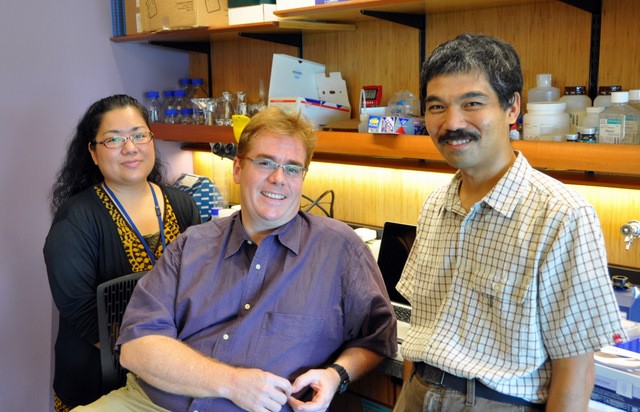Formation and Regulation of Neuronal Connectivity Research Unit
Principal Investigator: David Van Vactor
Research Theme: Formation and regulation of neuronal connectivity
Abstract
The mechanisms that control the formation and maintenance of accurate and functional synaptic connections are vital to the operation of the nervous system. While much remains to be learned about the molecular machinery underlying the specific directional growth of axons to reach target cells and the formation of synapses in the developing and regenerating nervous system, many of the genes needed for these events have been identified. This foundation of knowledge provides an opportunity to better understand the mechanisms that regulate the deployment of this molecular arsenal during normal development, or in disease states that compromise the function or survival of neural circuits. Multiple levels of regulatory mechanisms exist, from transcriptional to post-transcriptional and translational control of neural gene expression. Our interest is to better define such regulatory strategies.
Spinal muscular atrophy (SMA), a common genetic cause of infant death, is a devastating neurodegenerative disorder causing progressive loss of motor function due to malfunction of neuromuscular junctions (NMJs) and eventual death of motor neurons. SMA is caused by loss of Survival Motor Neuron (SMN1) gene, a component of the SMN complex involved in assembly of the small nuclear ribonucleoproteins that recognize and remove introns from pre-mRNA. SMN is thought to control the synthesis and the delivery of key synaptic proteins and mRNAs, although additional motor neuron specific functions are suspected. Thus, dissecting molecular circuit underlying the SMA neuropathology allows us to address outstanding questions of control the formation and maintenance of neural networks.
However, the identity of functionally relevant SMN target genes and the precise molecular role of SMN in nervous system and at the NMJ remain unknown. We employ SMA disease model developed in Drosophila, a powerful genetic model organism with well-conserved neuronal cell biology, and examine in what manner the reduction of SMN leads motor neurons loss. As previous screening to find genetic interactor of SMN demonstrated that alternation of components in two well characterized signaling pathways can either ameliorate or deteriorate phenotypes associated with SMN reduction, we will analyze the interaction between SMN and those signaling pathways in the formation and maintenance of the neuromuscular network. Furthermore, our long-term goal is to identify molecular circuit in which SMN integrated intervenes during establishment and maintenance of neuromuscular connection by using state-of-the-art sequencing technology available at OIST.
1. Staff
- Dr. Takakazu Yokokura, Researcher
- Ms. Shino Fibbs, Administrative Assistant
2. Collaborations
Nothing to report
3. Activities and Findings
Nothing to report
4. Publications
4.1 Journals
Nothing to report
4.2 Books and other one-time publications
Nothing to report
4.3 Oral and Poster Presentations
- Yokokura, T. 脊髄性筋萎縮症のメカニズムの解析 (Identfy genetic components that are related to the onset of neuromuscular disease, Spinal Muscular Atrophy). 沖縄産学官イノベーションフォーラム2010(Okinawa Innovation Forum 2010). Okinawa, December 17
5. Intellectual Property Rights and Other Specific Achievements
Nothing to report
6. Meetings and Events
6.1 International Workshops
Title: Developmental Neurobiology Course 2010
- Date: July 12-22
- Venue: Seaside House
- Organizers: Drs. mary Ann Price, Ichiro Masai, Robert Baughman (OIST), and Akinao Nose (The University of Tokyo)
- Speakers:
- Yoshiki Sasai, Group Director, RIKEN Center for Developmental Biology
- Li-Huei Tsai, Professor & Director, Picower Institute for Learning and Memory; Principal Investigator, Howard Hughes Medical Institute; Director of Neurobiology Program, Stanley Center for Psychiatric Research, MIT
- Masayuki Miura, Professor, Dept. of Genetics Graduate School of Pharmaceutical Sciences, Univeristy of Tokyo
- Frank Bernard Gertler, Professor, MIT, Koch Institute
- Elke Stein, Dept. of Molecular, Cellular, and Developmental Biology, Yale University
- Tadashi Uemura, Professor, Laboratory of Cell Recognition and Pattern Formation, Graduate School of Biostudeis, Kyoto University
- Kang Shen, Investigator, Howard Hughes Medical Institute; Associate Professor, Department of Biology and Pathology, Stanford University
- Morgan Sheng, Vice President, Neuroscience, Genentech Inc.
- Hitoshi Okamoto, Deputy Director, RIKEN, Brain Science Institute; Core Director, Neural Circuit Function Research Core; Senior Team Leader, Lab. forDevelopmental Gene Regulation
- John Flanagan, Professor, Dept. of Cell Biology, Harvard Medical School
- Nirao M Shah, Group Director, RIKEN Center for Developmental Biology
- Hideyuki Okano, Professor, Dept. of Physiology, Graduate School of Medicine, Keio University
- Alexander J. Whitworth, MRC Centre for Developmental and Biomedical Genetics, Dept. of Biomedical Science
- Thomas Walz, Howard Hughes Medical institute, Dept. of Cell Biology, Harvard Medical School
7. Others
Nothing to report






